Back to page 1
The Design
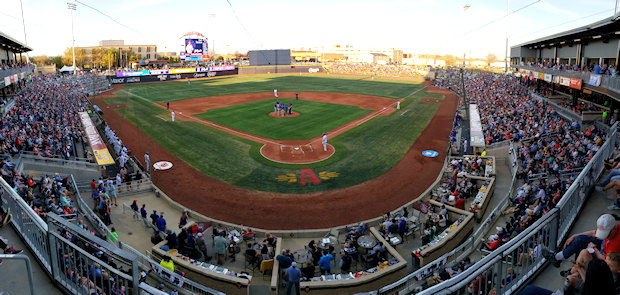
Aside from its striking art-deco entry rotunda, Hodgetown will be remembered for the way it raised the bar in social-gathering spaces.
First, let’s look at the upper deck. There is a big, beautiful lounge directly behind home plate that can be rented out for non-baseball functions. There’s a party deck on the third-base end to accommodate groups of up to 70. We’re seeing these two features at all new parks.
But what we’re not seeing elsewhere is the way the suites are configured.
 |
| The way the upper deck at Hodgetown is arranged is something many sports architects will be studying. |
You’re familiar with the way almost all suites are configured at just about any sports venue: an air-conditioned room with a glass door that leads out to two rows of seats, with the front row slightly lower (or “tiered”).
Sabatini refers to Amarillo’s upper-level spaces, though, as “patio suites.”
“Think of it like a party where everyone wants to hover around the island in the kitchen. So there is the (space) that is like the kitchen island and then just outside, there’s an outdoor patio that’s like a deck, with table top seating and drink rails.” In other words, the “patio” is flat, not tiered. See the photo below.
Says Sabatini, “I think this is the first time we’ve done a straight slab out from the suites.”
 |
| Quite a departure from the typical way seating is arranged in front of upper-level suites. |
He added, “Suites are evolving the way our culture is evolving, with greater importance on social gathering.”
Another example at Hodgetown are the concourse suites. Because the site for the ballpark had ample land, really wide concourses were possible. That opened the door to creating spaces that don’t, well, actually have doors. These suites are rented out by groups of up to 25 people and are sandwiched between the main walkway and the back row of seats.
The first time I spotted this kind of group area was at the new park in Columbia, SC — also a Populous project. The ones in Amarillo are more spacious, though.
 |
| Appearing more and more at new parks are “concourse suites,” wedged between the main concourse and the last row of the main seating bowl. There are four of them in Hodgetown. |
But wait, there’s more …
“In Amarillo, they wanted a level (of group space) that is in between the concourse suite and the patio suite,” Sabatini explained. “So we came up with what I think of as ‘hybrid suites,’ where you have the best seats in the house because you’re right on the field, but you can also go to an air-conditioned area if you want.”
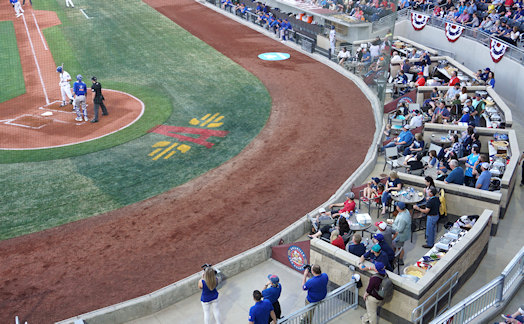 |
| These are the field suites as seen from the Club Seats in front of the upper-level lounge. |
There are five of these suites, located in between the field boxes and the backstop. You can’t get closer to the batter than these.
You actually access these using the same tunnel as the Sod Poodle players heading to their dugout. Making this even more wild is that visiting players must walk along the rear of these spaces to get to their dugout on the first-base side.
A group can book one of these units or several side-by-side. If you want a break from the heat, patrons can retreat to the upper level lounge via the elevator under the stands.
  |
| The colors of the masonry that separates the field suites are the same as on the exterior of the ballpark. Remember, these colors were inspired by the Palo Duro Canyon. The other photo gives you an idea of how close you are to the batter. |
“And there’s no roof over them,” Sabatini added. “You’re out in the open where you can be seen, and in Amarillo, they like that. The Mayor talks a lot about Amarillo being an open, transparent city,” and this is as open as you can get.
While First Tennessee Park in Nashville isn’t my favorite new stadium of recent years (for instance, concourse suites wouldn’t work well there, because the front of the upper deck hangs so low above the field seats), its social area in the right-field corner is a runaway hit. Every new park attempts to emulate it. In Amarillo, that attempt is in left field. Bar 352’s name comes from the fact that it’s 352 feet from home plate. It uses the open-on-all-four-sides approach that’s so popular in ballpark tiki bars and such.
  |
| Bar 352 is really attractive. Its design lets fans keep an eye on the action while enjoying a drink with friends. |
Another advantage of having such a large parcel of land for the ballpark is that there is room to expand. Below you see the area that would ordinarily have inflatables for kids, but because the unseasonable weather hadn’t been conducive to solid grass growth, the front office opted to keep fans off it in the early stages of the inaugural season.
 |
| There are wide-open spaces beyond right field at Hodgetown. When the grass is more established, this will become the Ruckus’ Kids Corral (Ruckus in the mascot). You can see the jungle gym is already in place. |
When Sabatini was giving me a tour of the park prior to Opening Night, he pointed out the netting that stretches from the far end of one dugout to the far end of the other. He wanted me to notice its color: green. “When you use green netting instead of the standard black, it seems to be more invisible to the fan looking through it,” he elaborated. Indeed, I found it to be much less noticeable than what I found at the new ballpark in Las Vegas on its Opening Night a day later.
  |
| This is the green netting that research indicates is easier to see through than white or black. The other shot shows the immensity of the video board as well as the ribbon boards that run all along the top of the left-field wall. |
A clever design element is the placement of indoor batting cages in between the third-base concourse and Buchanan Street. Fans at a game can watch batters take practice cuts — but so can pedestrians walking outside the ballpark. This is also a feature in Fayetteville’s new stadium.
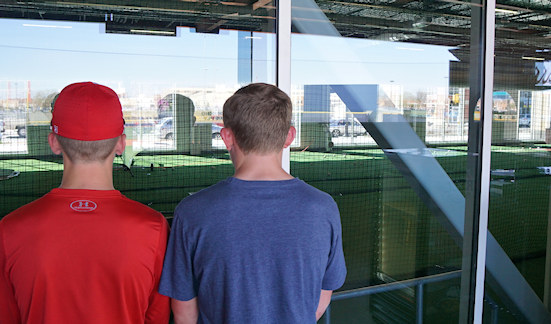 |
| The indoor batting cages can be seen from both inside and outside of the park. |
And finally, one sensational architectural element of Hodgetown and one that is awful — both of which you might not even notice.
The sale of merchandise is quite important to the ownership of a team. That makes it quite unfortunate when a store is too small, poorly designed or the selection of souvenir and apparel is lacking. In Amarillo, they did an exceptional job with all phases.
We’ll talk more about the merchandise itself in our next section, but the design of the team shop is brilliant. It’s exactly the right size at 1,450 square feet, and it has three doors — one on the concourse so fans at a game can get in, one from the administrative lobby of the park and one from the entry plaza on Buchanan Street so it can be accessed on non-game days.
Not only that, there’s an advance ticket window actually inside the store. “We did that so when a fan at a game wants to buy tickets for a future date, he’ll also see our great merchandise,” explained Sod Poodles President and GM Tony Ensor.
Adds Brian Simpson, Lead Project Architect of Hodgetown, “Our store was strategically placed for the most visibility and to draw (fans) to that corner.”
Plus the store is arranged perfectly to make it convenient to shop and to show off all of the great Sod Poodles gear.
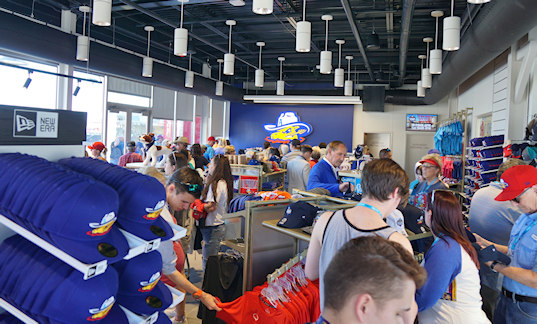 |
| The store in Hodgetown is one of the nicest in the Minors. |
Unfortunately, the terms “brilliant,” “perfect” or “convenient” can’t also also be applied to the pressbox.
| Media doesn’t matter |
 |
| Not that you probably care, but this was my view during the time I spent in the pressbox. |
It is located at the extreme right-field end of the upper level, forcing the broadcasters to lean out of their booth to see the backstop. Worse, writers on the second tier of seats can’t see the batter or pitcher at all. And to add insult to injury, the closest restrooms are located on the far end of the lounge in the center of the upper deck.
I’m not implying that we media types should be treated well, but this might tie Hartford’s Dunkin’ Donuts Park for my least favorite pressbox.
To be fair, the architects weren’t crazy about the location of the press area or its abysmal sightlines. But the funds weren’t there to construct it elsewhere, like on the roof behind homeplate, like in Round Rock or the new park in Las Vegas.
Setting aside the mistreatment of the press, this is a lovely ballpark with an attractive and functional design. The art deco touches are extremely well done and make it the most aesthetically pleasing of the new parks to open in 2019.
But what is it like to attend a Sod Poodles game?
The Essentials

Years of planning by the City of Amarillo led up to the moment shown above: the first pitch at Hodgetown by Reggie Lawson at 7:07 p.m. on April 8, 2019.
The park was packed with excited fans, many of whom hadn’t been born the last time an affiliated Minor League game was played in Amarillo in 1982.
As the newness wears off and fans become a little more conscious of what it costs to attend a Sod Poodles game and how they are treated once inside Hodgetown, they’ll start focusing on the gameday experience.
Fortunately, it’s quite good.
First, let’s look at costs. The team controls three surface parking lots to the north of the ballpark. The cost is $5. A little closer is the City-operated parking garage on Buchanan Street at 6th Avenue. They charge $7. To the east and south of Hodgetown, you’ll find parking along some (but not all) streets. They stop charging at 5:00 p.m.
 |
| Buy a general-admission ticket and get to the ballpark early. Maybe you’ll be able to grab one of these tables. |
Seats behind home plate and the dugouts are all sold as season tickets. The face values of those seats are $18, $16 and $14. You have a shot at reserved seats just beyond first base and third base at $12, and those near the foul poles are $10. To sit on the berm in right field or to stand at the bar or one of the drink rails is a very reasonable $6. Note: if you’re there when the gates open, you have a great shot at landing one of the first-come-first-served tables along the left-field wall (see photo above).
The food options are plentiful, if a little pricey.
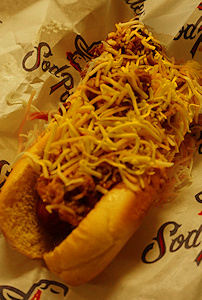 Near the left-field entry gate is an area you might call Carnivore Corner. There’s a kiosk manned by Dickey’s BBQ with a Frito Pie for $9.75 and a Brisket Sandwich for $7.75. Nearby is the Palo Duro Grill featuring either a Patty Melt or a Black Angus Bacon Burger for $12. Next to it is the Santa Fe Cantina where a set of three Street Tacos is $7.75 and Steak or Chicken Loaded Nachos are $12.50.
Near the left-field entry gate is an area you might call Carnivore Corner. There’s a kiosk manned by Dickey’s BBQ with a Frito Pie for $9.75 and a Brisket Sandwich for $7.75. Nearby is the Palo Duro Grill featuring either a Patty Melt or a Black Angus Bacon Burger for $12. Next to it is the Santa Fe Cantina where a set of three Street Tacos is $7.75 and Steak or Chicken Loaded Nachos are $12.50.
If you’re really hungry for nachos, though, go to Nacho Libre behind third base, where the whopping Funk Family Nachos Helmet is $15.
I opted for the slightly shorter line at Diggity Dog behind home plate, where a delicious Chili Cheese Dog (see photo) was $7.50.
The stands with interesting takes on standard ballpark fare are called Route 66 Grill, Feed and Seed, and Barn Yard, going counter-clockwise from third base around to first.
The Western Son stand behind home offers mixed drinks and HTeaO beyond third base offers a dozen flavors of tea for $6 for 32 ounces and $7 for 44.
So there is more variety here than at Fayetteville’s new park, but less than the new showplace in Las Vegas.
And what about that fabulous team store? You know, I attended the ceremony at the Embassy Suites last fall where the franchise revealed that the team nickname was going to be Sod Poodles. I knew that this team was going to hit it out of the park with apparel when immediately after the big announcement in the hotel ballroom, they invited attendees to shop at their fully stocked store in a room at the hotel. They already had dozens and dozens of items prepared to sell before the nickname had even been revealed!
With several months to prepare, Director of Merchandise Katarina Burns and her staff offered a dizzying number of cute and colorful items for Opening Day. I couldn’t have been more impressed.
 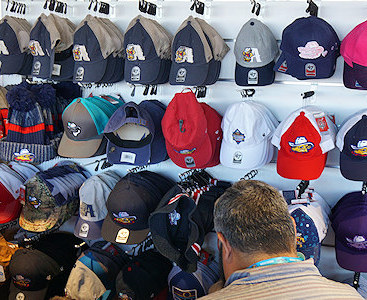 |
| While the team store is stuffed full of wonderful shirts and souvenirs, the cap selection really blew me away. |
Sweatshirts for adults were $35 and $50 and hoodies were $45, $60 and $62. Adult tees were $20-27 and Dri Fit tees were $37. Kids T-shirts were $14-20 with lots of imaginative takes on the cute Sod Poodles logo.
Adjustable, embroidered caps were $23-28 and printed caps were $22-25. All fitted caps were $34. Kids caps (again, great variations) were $20-28.
And unlike Vegas (which opened the following night), they had lapel pins in stock at $6.
The video board in left field is 60′ by 35′ and has a really high resolution, although it suffered quite a few malfunctions on opening night. The technology is there. It will be great.
In fact, the gameday presentation by the Sod Poodles staff was really solid and the food-and-beverage quality was definitely above average in the Minors.
Hodgetown was in midseason form on Opening Night.
Summary

Almost as if to say “We’re going to deliver the goods and stay here for the long haul,” at the end of Opening Night, the Sod Poodles put on one of the most impressive and extensive fireworks displays I’d ever seen at a ballpark.
And even though it was a weeknight and the game had gone extra innings, almost everyone stayed to see it.
One can see that the Sod Poodles should have a long, successful run in the Texas Panhandle. They are definitely making the most of the way the dominoes fell their way.
So let’s clear up two mysteries: why is the ballpark called Hodgetown? And what exactly is a sod poodle?
The park’s name pays tribute to Jerry Hodge, who is as accomplished as anyone in the Texas Panhandle. He was the youngest person ever elected mayor of Amarillo. At age 23, he bought a small downtown drugstore and built it into the 1,000-employee pharmacy service company it is today. He was instrumental in bringing the Texas Tech School of Pharmacy to Amarillo and is a tireless supporter of numerous community causes.
And he made it his mission to bring Minor League Baseball back to the Panhandle.
At a large gathering at the Amarillo Civic Center on January 24, 2019, Hodge was honored as the Amarillo Globe News Man of the Year.
Hodge and other entities the team calls “founding partners” pooled funds to support the ballpark and also to create a Champions for Charity initiative to support local non-profits. In exchange, the team pitched a naming-rights arrangement to Hodge that the facility would bear his name.
But what’s a sod poodle?
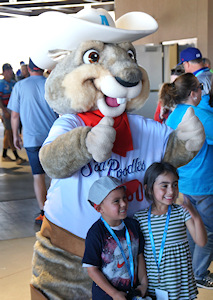  |
| The much-larger-than-life mascot has a cute and clever name befitting a sod poodle: Ruckus. The other photo shows the head Sod Poodle himself, team President and GM Tony Ensor, and former Texas League President Tom Kayser. Kayser was involved in the discussions involving the move of the Missions from San Antonio to Amarillo. |
According to folklore, pioneers settling the plains of the Texas Panhandle often referred to prairie dogs as “sod poodles.” When the team was moving from San Antonio to Amarillo, they knew that “Missions” wouldn’t make any sense as a nickname. So they did what every smart franchise does: a name the team contest.
Over 3,000 different suggestions were submitted by fans. The list was narrowed down to these finalists: Boot Scooters; Bronc Busters; Jerky; Long Haulers; and of course Sod Poodles.
I attended the big “reveal” ceremony at the downtown Embassy Suites on November 13, 2018. When I spotted that the team had bused in dozens of elementary school students to sit in the front rows of the audience, I had a strong feeling what the winning name was going to be.
Indeed, when Tony Ensor announced that the team’s nickname was going to be Sod Poodles, the ear-piercing squeal from the front rows could be heard for blocks. And as mentioned earlier, the shrewd marketing minds in the front office know an opportunity when they see one, as they announced that everyone in attendance should check out the makeshift store down the hall that was chocked full of adorable, colorful Sod Poodles apparel.
The race to the cash register was on.
As Ensor told the media back in November, the team wanted to create “an iconic identity that appeals to kids and families and is unlike any other in the country.” It’s certainly unique and is an overwhelming hit with kids.
I guess a team identity where the mascot is a huge black domino tile wouldn’t have generated the same appeal, even though the dominoes fell into place perfectly for baseball fans in the Texas Panhandle.
Have something you want to say or ask about this review? Use the Comments box below.